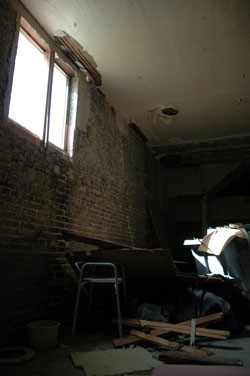In many ways, the exterior of the vacant building at 113 Palmetto Ave. in Sanford looks like the rest of the city’s historic downtown: old-fashioned, with quaint turn-of-the-century appeal.
But the inside of the building is a shell; the floors are cracked concrete; there are open holes in the walls and rotting, splintered beams in the ceiling. Loose nails, light bulbs and wood scraps litter the floor.
“It’s obvious the previous owners couldn’t make a go of it,” says Robin Butler, president of the nonprofit Lighthouse Real Estate Investors Association. “Apparently they didn’t know the gravity of the situation.”
The same could be said of everyone who has owned the building in recent years. That’s because about 50 years ago, dry-cleaning solvents were dumped behind the building, contaminating the soil and aquifer. For years the property has changed hands as one owner after the next decided they couldn’t afford to clean up the mess. The Lighthouse received the building as a gift in 2006 with the idea of finally dealing with the problem.
So far that hasn’t happened, because the city of Sanford doesn’t view the cleanup as a priority. City officials are more concerned with the building looking good than they are with the ground underneath it being free of contaminants, assessing more than $65,000 in fines for things like broken windows and missing trim.
Sanford has also blocked a move by the Lighthouse to get the site designated as a brownfield by the Florida Department of Environmental Protection. The designation would make the property eligible for cleanup money, but Sanford officials are afraid it would sully the image of their downtown.
Even with cooperation from the city it could take more than a decade to thoroughly dispose of contamination, says Butler. But without help, the building could become a piece of crumbling downtown history – one that might make you sick.
A light in the dark
The building, which sits on a quiet street on the edge of downtown near Lake Monroe, has a lively history. In the late 1800s, it housed a blacksmith and wagon shop, and later a feed and sales barn. In 1916 it became the Seminole County Jail, and later the Seminole County Health Department. At one point an adjacent building was co-opted to double the space. Both buildings are included in a historic downtown walking tour and are listed on the National Register of Historic Places.
But the building’s current woes stem from its time as a dry-cleaning shop from 1956 until 2000, when it was vacated. Sanford Drycleaners closed in 2000, shortly after receiving an increasing number of demands from the state to clean up the contamination. In September 1999, then-owner Dan Porter received a final letter threatening fines and penalties a month after he applied for funding from the state’s Dry Cleaning Solvent Cleanup Program. (The Florida Department of Environmental Protection gave Porter two months to apply to the program before commencing enforcement in 1997, yet his application wasn’t received for another two years.)
The 1999 letter cautioned that the business was in violation of state statute by allowing an “imminent hazard” to remain, and warned “any activity at your facility that may be contributing to violations of the above described statutes and rules should be ceased immediately.”
In the summer of 2006, then-owner Tamara Ransom decided she was unable to foot the bill both for renovation and cleanup and decided to get rid of the property. “If we are asked to spend thousands of dollars in clean up of a chemical that has been in the ground for years and was spilled by a previous owner we will have no other choice but to walk away from our dream of having our home and business in the downtown historic Sanford area,” Ransom wrote to the city in April 2006.
A member of the Lighthouse overheard Ransom’s frustrations and her plans to move the property into the hands of a nonprofit for the tax break. Ransom gave the property to the Lighthouse as a gift in August 2006.
“We did it because we can and because it’s the right thing to do,” says Butler, noting that the Lighthouse’s mission is to promote high standards of business ethics, professionalism and fair housing based on Biblical principles. Members subscribe to a set of fair-practices standards for landlords. (While a Christian organization, those standards have no religious basis.)
Butler says the Lighthouse plans to spend about $2.1 million renovating and cleaning up the property; it will be worth about $700,000 after it has been rehabbed. After taking ownership, the Lighthouse transferred the title over to its community service arm, Metro Orlando Affordable Housing, a 501(c)(3) they figured would have a better shot at winning matching grants from the state.
The Lighthouse plans to use a large front room as a gallery for fledgling artists and a back room for educational workshops. They also envision a community room where local groups and civic organizations could meet and as many as three small apartments for emergency housing.
Long, dirty history
Contamination at the site was first documented in a January 1993 Contamination Assessment Report written by Environmental Solutions and Services, an environmental consulting company, for Thrifty Service Station, a defunct gas station that operated on the lot next door.
The report was initiated based on suspected petroleum contamination. But Environmental Solutions found both petroleum and chlorinated hydrocarbon compounds -– dry-cleaning solvents – in the ground. Records indicate that the solvent perchloroethylene, commonly called “perc” but more formally known as tetrachloroethylene, was used in the business in the ’60s and ’70s, while an earlier owner had used petroleum-based cleaning agents.
That report revealed a test area at 113 Palmetto Ave. with 28 micrograms per liter of tetrachloroethylene and 19 micrograms per liter of trichloroethylene, a hazardous breakdown component of the chemical. DEP’s target level is below three micrograms per liter for both chemicals.
A separate report from environmental consultant ESSI Omega noting similar levels of contamination was turned over to DEP in late 1993. A 1999 report by ENCO Laboratories showed contamination of 72,000 micrograms per liter of tetrachloroethylene and 420 micrograms per liter of trichloroethylene. That report was contracted by then-building owner David Rosenbloom in an effort to enter the state-sponsored Drycleaning Solvent Cleanup Program. However, the application was turned in late and denied after an appeal.
In July 2007, after two years of investigating, the DEP released its first assessment, which revealed soil contamination near the building’s back door and in the surrounding vicinity and groundwater contamination in both the shallow and deeper surficial aquifer, an underground layer of water-bearing rock from which groundwater is extracted. Identified contaminants included perchloroethylene (75,000 micrograms per liter at the most potent section tested) and trichloroethylene (19,000 micrograms per liter at the highest reading.) Topsoil less than two feet deep – soil most likely to be disturbed by area residents – contained eight times the target level of contamination.
The extent of the soil contamination wasn’t pinpointed because the entire site isn’t accessible. Much of the property is under a layer of concrete, and no testing was done beneath the building.
“The horizontal and vertical extent of the solvent contamination within the Intermediate Aquifer System and the Floridan Aquifer has not been determined and warrants further investigation to achieve delineation to FDEP contaminant clean up target levels,” the DEP report reads. “However, solvent contamination was documented in the surficial and deeper portions of the surficial aquifer to a depth of 40 feet and is likely to be found at much greater depths as evidenced by the high concentrations found in the deeper monitor wells.”
The solvents, which are denser than water, have a tendency to sink and spread, meaning it is likely that deeper and wider contamination exists. The Floridan Aquifer, from which the majority of the state -– Sanford included – draws drinking water, can be tapped about 100 feet below ground in Central Florida.
Another assessment will be needed to identify how far the contamination has spread horizontally and vertically, and to locate the plume, or source, of the contamination. Both the Floridan Aquifer and Lake Monroe – which is less than a quarter-mile away – will be tested. DEP’s report indicates concerns that the contaminants may have reached the lake.
The Lighthouse hired American Compliance Technologies in December to do a $175,000 comprehensive investigation of the site. That review should be complete late this year.
“The information we have now is very sparse,” says Stoddard Pickrell, a geologist and project director for American Compliance Technologies. “We’re trying to get a better idea of where the contaminants are and what we need to do. We’re not going to find anything horrific. The levels are higher than you’d like to see but not unmanageable.”
Always spreading
When dry-cleaning operators began dumping old chemicals behind their shops in the ’60s (likely earlier, but there’s no documentation to confirm that) no one realized the potential hazards associated with the chemicals, which sink into the ground and degrade at a painfully slow pace, says Dr. Cherie Geiger, an associate chair and professor for the University of Central Florida’s chemistry department.
“These things cause cancer,” Geiger says. “It just stays down there and keeps contaminating and keeps contaminating.”
Inhaling tetrachloroethylene fumes can cause respiratory tract irritation, giddiness, headache, intoxication, nausea and vomiting, according to a Material Safety Data Sheet on the chemical. Exposure to massive amounts can result in liver and kidney damage, breathing arrest and death. It is linked to cancer, and long-term exposure can damage the central nervous system.
Trichloroethylene has similar effects but also can cause visual disturbances and mental confusion, coordination problems, cardiac effects and unconsciousness.
People who use wells are most vulnerable to the chemicals, even if the well water isn’t used for drinking. The DEP report indicates there are no wells in the area; however, at least one resident on the same block taps an irrigation well.
Margaret Duggar, who resides at 118 Sanford Ave., behind the former dry cleaner, has an irrigation well on her property that she added 11 years ago. Duggar runs the well twice a week to water her grass and plants. She says she’s not concerned because the state has never warned her about having an irrigation well and because she doesn’t drink the water.
“I haven’t been concerned because the state approved it when we first put it there,” she says.
However, the DEP has no record of wells within the vicinity of the former dry cleaners. And they were surprised to hear of one.
“If someone had a well in the surficial aquifer, that would be a problem,” Tom Lubozynski, waste program administrator for DEP, says. “It will put solvents in the atmosphere and will bring in concerns with people breathing it.”
Other than the well, Lubozynski says he does not believe that the contamination poses a threat to the community. “As far as any impact right now to public health, we don’t think so,” he says. And he points out that the city’s water is regularly tested and meets state standards.
He does lament that assessing and cleaning the contaminated property has turned into a lengthy process. Frequent changes of owners who couldn’t afford to get it done have added to the problem, as has miscommunication inside DEP.
After building owner David Rosenbloom was denied entry into the Dry Cleaning Solvent Cleanup Program in 1999, DEP accidentally closed the case instead of pursuing enforcement actions, Lubozynski says. The case wasn’t reopened until 2003, when someone became interested in purchasing the property and DEP discovered that the case had been closed.
Make it pretty
When the Lighthouse took custody of the building in August 2006, its officials immediately began looking into cleaning up the contamination. They began searching for a company that could assess the property, reviewed previous reports and got in touch with DEP.
They knew the building was in violation of city code. It had deteriorating wooden molding, broken windows, old doors and peeling paint. So they repainted the exterior and boarded the broken windows within two weeks of acquiring the property.
But that wasn’t enough for the city, which sent the Lighthouse letters of noncompliance detailing the code for historic landmarks and started assessing fines of $250 a day shortly thereafter. The Lighthouse got a four-month extension, but had difficulty locating the required “historically appropriate” doors and windows. The updates ended up taking eight months, instead of four. (Since then, vandals have broken all three rear windows.)
“This is an old building. You can’t just go to Home Depot,” says Rick Kanaga, the Lighthouse’s property manager. “We’re talking about custom-made wood frames. We want to restore the historical aspect, but our initial concern was the contamination.”
But to the city, the contamination takes a back seat to city code, says Kanaga. “The city is more concerned with the outside of the property. What they care about is downtown and helping their vision. Our drive is not consistent with economic development.”
By the time the Lighthouse had complied with code, the city sent them a bill for $65,000 in code violations. At a January meeting, city commissioners agreed to cut the fine in half if it’s paid by May. The Lighthouse doesn’t plan on paying. Kanaga calls the fine “arbitrary” and says the city has done nothing with the building except assess fines to pad their general fund.
“They should give us $65,000 for doing nothing all these years,” Kanaga says. “Our goal is to solve a problem that no one else has solved. … We’re trying to rectify years of problems. We believe the city should not be as concerned with broken windows and peeling paint.”
The city thinks otherwise. Christine Dalton, Sanford community planner and also the city’s historic preservation officer, says the Lighthouse boarded windows without permission and didn’t have a required maintenance plan to spray for bugs.
“The Lighthouse has done a great deal,” Dalton says. “They did finally fulfill that, but it didn’t happen soon enough. It should have been done immediately.”
The city is concerned with contamination, she says, but notes that the problem has been there for 50 years, and complying with code should have been the priority.
The Lighthouse also has met with city resistance in their quest to have the site declared a brownfield, a voluntary state designation for blighted or contaminated areas. They first requested the designation – which comes with benefits including tax breaks, sales tax refunds and funding to aid in cleanup – in November, but were told that city commission wouldn’t consider it.
Dalton says the idea of designating the site a brownfield has been brought up before, but expresses concern about the ramifications on the image of Sanford’s historic downtown.
“When you say ‘brownfield,’ people immediately have a negative connotation,” she says. “When people hear ‘brownfield,’ they think ‘contamination’ and that people will get sick.”
Acting city manager Kristi Aday also says the Lighthouse has asked staff members to declare the site a brownfield. However, the city says there was no “formal request” so it hasn’t been brought forward, though Aday also admits there is a dilemma with the “image of a brownfield.”
City officials also have sought to downplay the organization’s concerns. In a Jan. 25 news release in response to a newsletter the Lighthouse circulated to members, city officials called the contamination assertions “vague claims” and said it is the Lighthouse “alleging [contamination] has seeped into the
aquifer.”
“The Lighthouse’s newsletter contained quite a bit of conjecture about the amount of contamination and its location,” Aday is quoted as saying in the release. “I don’t think the level of contamination is actually known. Is there contamination? Probably. It’s not uncommon at these former dry-cleaning facilities. But the owners won’t know until they have the appropriate testing done.”
Sanford Mayor Linda Kuhn, who voted against cutting the Lighthouse’s fines, didn’t return calls for comment. In the release she says the Lighthouse is trying to blame someone else for its own stumbling blocks.
“This campaign by the Lighthouse appears to be an attempt to divert attention away from the fact that they purchased a property with problems – soil contamination and liens – but want to place the blame and responsibility somewhere else,” Kuhn says in the release.
Not a priority
On the second-floor terrace at 113 Palmetto Ave., a subtle breeze blows. Butler’s shoes stick to the black rubbery surface as he approaches the edge.
Over the ledge are views of several tiny downtown homes and apartments. Goodwill’s Self Sufficiency Job Center is adjacent, and a handful of small businesses are nearby, among them a soul food restaurant serving up oxtail soup and chitterlings. A small shop selling natural cleaners, botanical disinfectants and aromatherapeutic pet cleansers is on the corner.
“We’ve lived in a world where in the past people didn’t care about the environment,” Butler says.
Now it’s a world where it’s not necessarily a priority.
[email protected]



















